 |
| Image is from Flickr.com under a Creative Commons license |
Thursday, May 31, 2012
Guess the Genotype #74
Can you guess this dog's genotype? Its breed?
Biology Trivia Answers: Cell Bits
Answers
Yesterday, I posted the following five statements and asked you to pick out the false one:
- Aquaporins: A channel protein has been discovered in cell membranes that has been named aquaporin. As you might have guessed, these channels are basically pores that allow water molecules to be more easily transported through the membrane.
- Endoplasmic Reticulum: This organelle, also called ER, usually comes in two different types: rough and smooth, with the rough having ribosomes attached. However, bacterial ER only comes in the smooth type as the bacterial ribosomes are unable to attach to the membrane surface.
- Actin and Myosin: The motor protein actin and the cytoskeletal filament myosin form bundles in your muscle cells. Using energy from ATP, actin moves along the myosin to cause the muscle to contract.
- Mitochondria: Those amazing organelles known as the mitochondria have their own DNA which is inherited completely differently from the DNA in the nucleus. Whereas nuclear DNA comes from both parents, the nature of egg and sperm mean that mitochondria DNA is only passed from mother to offspring.
- Lysosomes: Normally acting to break down molecules in the cell, lysosomes are capable of killing the cell if they break open.
2. Endoplasmic Reticulum: This statement is false! Bacteria, being prokaryotic, has no membrane-bound organelles. Most people only remember prokaryotes as having no nucleus, but the differences between prokaryotes and eukaryotes are more fundamental. The only organelles that bacterial cells do have are ribosomes. It is true that the bacterial ribosomes are different from eukaryotic ribosomes, but the differences have nothing to do with the ability to attach to ER.
Wednesday, May 30, 2012
Biology Trivia: Cell Bits
Cell Bits Edition
I've decided to try out a new blog topic: Biology trivia! All of the five things below are either something that is indeed true about a topic pertaining to Biology, or something that I made up. Can you pick out which one of these statements are facts and which is completely false?
- Aquaporins: A channel protein has been discovered in cell membranes that has been named aquaporin. As you might have guessed, these channels are basically pores that allow water molecules to be more easily transported through the membrane.
- Endoplasmic Reticulum: This organelle, also called ER, usually comes in two different types: rough and smooth, with the rough having ribosomes attached. However, bacterial ER only comes in the smooth type as the bacterial ribosomes are unable to attach to the membrane surface.
- Actin and Myosin: The motor protein actin and the cytoskeletal filament myosin form bundles in your muscle cells. Using energy from ATP, actin moves along the myosin to cause the muscle to contract.
- Mitochondria: Those amazing organelles known as the mitochondria have their own DNA which is inherited completely differently from the DNA in the nucleus. Whereas nuclear DNA comes from both parents, the nature of egg and sperm mean that mitochondria DNA is only passed from mother to offspring.
- Lysosomes: Normally acting to break down molecules in the cell, lysosomes are capable of killing the cell if they break open.
Tuesday, May 29, 2012
Crazy Plants: Eelgrass
 |
| Eelgrass (Zostera marina) at low tide |
 |
| Submerged eelgrass |
 |
| Closeup of eelgrass blades |
Unfortunately, eelgrass and other seagrass beds are at risk due to a number of factors. Boat propellers and dredging operations will destroy beds directly. In contrast, runoff from land can lead to increased turbidity that can shade out beds. Also, this runoff can bring excess nutrients and lead to heavy algae growth, which will also shade out beds. The damaging and loss of beds had led to decreases in fish populations, though the exact amount of loss can't really be determined. Though these concerns do exist and eelgrass populations are decreasing, they are still considered to be of Least Concern by the IUCN.
Sources are the Maryland Department of Natural Resources, University of Delaware, Washington State Department of Ecology, and IUCN Red List. Images are from Wikimedia Commons and are under Creative Commons licenses or are copyright free: one, two, three.
Homemade Frozen Dog Treats
Since today's been horribly dreary thanks to Beryl, I decided to finally get around to posting about this little project. I mentioned that I was thinking about making homemade frozen yogurt treats when I reviewed Freshpet's Wag-gurt. Well, I did.
Materials:
Large mixing bowl
Something to mix with (I used a large spoon)
Mold that can be frozen (I used a standard ice cube tray)
- Try to choose a mold appropriate for the size of your dog.
Ingredients:
56 oz yogurt (I used 32 oz plain yogurt, 24 oz plain Greek yogurt)
12 oz jar peanut butter (chunky)
1 tbsp honey
Apple juice
Directions:
I actually made and froze the whole batch of these suckers several weeks ago now. It took me several days to freeze the entire mixture since we only have one ice cube tray this size (the others make teeny tiny cubes). I intended to count how many treats were made, but I lost track around the fourth tray-full or so. I think there are about eighty treats. Since Ebon was having some issues while I was freezing them, he hadn't been able to try them yet. The verdict?
He loves them! The only issue is the cubes I made (about two ounces or two cubic inches) were rather too small for Ebon as he wanted to chew rather than lick them. For a dog Ebon's size, I would suggest an ice pop mold or perhaps used, cleaned pudding cups for a cheaper option (really, anything about six ounces would do). I'm considering options to deal with this small size. I'll probably end up thawing a bit on one and then freezing it to another or something of the sort. I just don't want Ebon trying to swallow them whole.
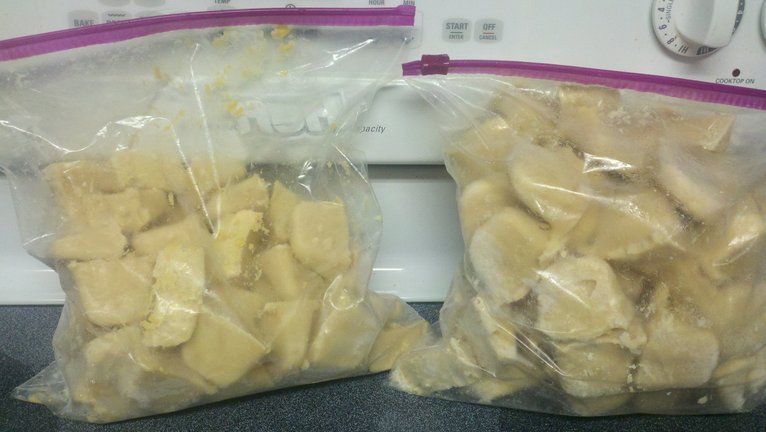 |
| All of the treats I made in gallon-sized bags. For about twice the price of the Wag-gurt you get the equivalent of around four times the treats. These should last all summer at the very least! |
Large mixing bowl
Something to mix with (I used a large spoon)
Mold that can be frozen (I used a standard ice cube tray)
- Try to choose a mold appropriate for the size of your dog.
Ingredients:
56 oz yogurt (I used 32 oz plain yogurt, 24 oz plain Greek yogurt)
12 oz jar peanut butter (chunky)
1 tbsp honey
Apple juice
Directions:
- Combine yogurt, peanut butter and honey in a large mixing bowl. Mix until no more globs of peanut butter can be seen. The consistency should be smooth and pudding-like if you ignore the bits of peanut.
- Add apple juice until the mixture becomes watery.
- Pour into mold and freeze until firm.
- Remove from mold and serve.
- Substitute fat free yogurt for a pup who could loose a few pounds.
- Replace peanut butter and honey with your pup's favorite fruit (mashed).
- Leave out honey and replace apple juice with water for a pup that has issues with sugar.
- Replace honey and peanut butter with your pup's favorite meat (ground or chopped fine) for a more savory treat.
- Use your imagination!
I actually made and froze the whole batch of these suckers several weeks ago now. It took me several days to freeze the entire mixture since we only have one ice cube tray this size (the others make teeny tiny cubes). I intended to count how many treats were made, but I lost track around the fourth tray-full or so. I think there are about eighty treats. Since Ebon was having some issues while I was freezing them, he hadn't been able to try them yet. The verdict?
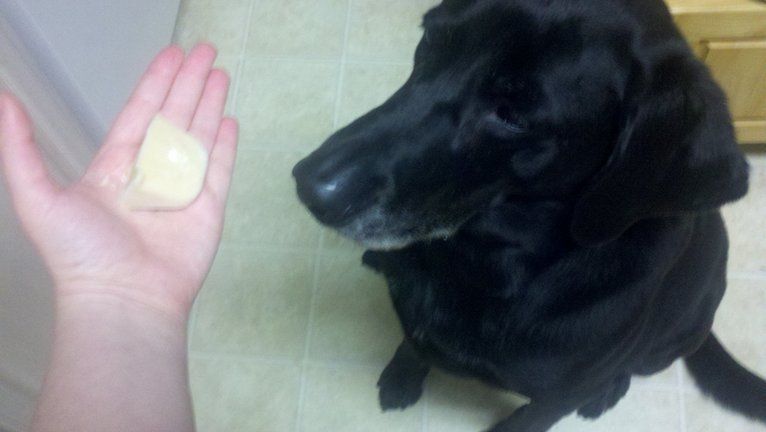 |
| What's that? Smells like peanuts. |
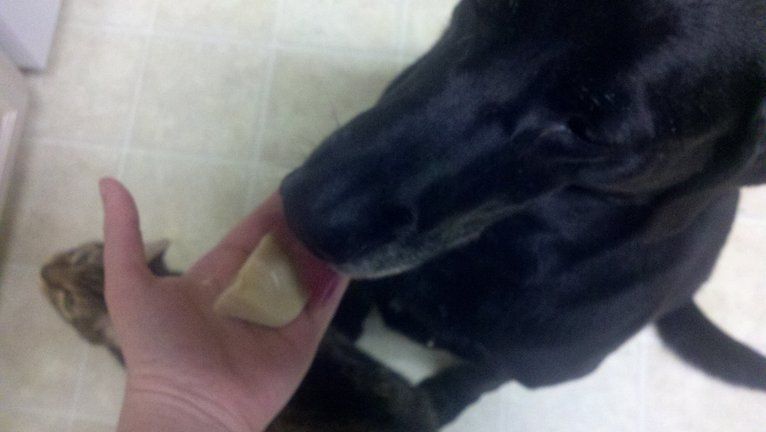 |
| Lick, lick. Yum! |
Monday, May 28, 2012
Invasive Species: Eurasian Collared Dove
 |
| A Eurasian collared dove (Streptopelia decaocto) in Polland |
The main source of introduced birds has been through the pet trade. For example, birds are believed to have escaped from a breeder in Bahamas in the 1970's. These escapes are believed to be the sources of the birds now seen in the Bahamas, as well as the Caribbean and the North America.
There are several major concerns involved with having these birds become an invasive species. For one, they compete with native species such as the turtledove and mourning dove. They are also known for fouling and eating grain crops and products, and are thus an agricultural nuisance. They are also known to carry West Nile virus, and are believed to be possible amplifiers that, as carriers, could cause outbreaks of the disease. They also carry another virus, pigeon circovirus, which has the potential to kill dove and pigeon species that the collared dove may come in contact with.
This is a species that I have seen in my area. It's hard to miss that black collar. As with any invasive, it concerns me greatly whenever I spot one. In certain parts of the bird's introduced range, they are popular with hunters. Hunting can be one of the most effective methods of controlling an invasive species, so I see this as a positive thing.
Source is the Global Invasive Species Database. Image is from Wikimedia Commons under a Creative Commons license.
Sunday, May 27, 2012
Guess the Genotype #73
Can you guess this mamma dog's genotype? What about her breed? What about the father of this litter?
 |
| Image from Wikimedia Commons under a Creative Commons license |
Thursday, May 24, 2012
Evening Romp
 |
| Ebon on the stage |
 |
| In a down-stay on the soccer field |
The bugs were out in force and though I remembered my bug spray this time, I still ended up getting a few bites. Those darn mosquitoes just love me too much. It was a beautiful day, though. Only a bit warm and really not humid. It's usually extremely humid around here and after a week of frequent rains it seems that things have dried up for the time being. Ebon enjoyed himself. He's doing great right now, for those of you who are curious.
 |
| On a man-made sand mound that's in the woods |
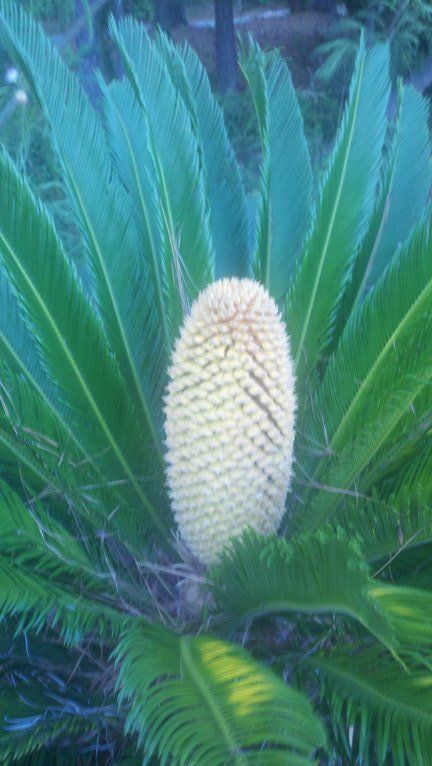 |
| Male sago (Cycas revoluta) cone |
Are Orcas Whales?
 |
| Wild orcas (Orcinus orca) off the coast of Alaska |
 |
| Baleen of a feeding humpback |
 |
| A killer whale skull |
If this isn't enough evidence to make you agree that orcas are whales, consider the fact that phylogenetic studies always place whales, including the toothed ones, as grouping separate in relation to their next closest relatives, such as the hippo. Though the toothed whales and baleen whales did branch away from each other quite some time ago, they share a common ancestor (with teeth, mind you) that can only be called a whale.
Sources are Animal Diversity Web (University of Michigan), University of Bristol, National Oceanic and Atmospheric Administration, and National Geographic. Images are from Wikimedia Commons and are under Creative Commons licenses or copyright free: one, two, three.
Tuesday, May 22, 2012
Cool Animal Sounds: Cicada
It's been a while since I've featured an insect in one of these. This time around, it's the cicada, whose call an be heard beginning at 0:15 in the video below.
What you hear in that video is the cicada's mating call and they basically "pop" a membrane, known as a tymbal, in their abdomen to make it. Cicadas are amazingly loud creatures, and if you have a large number singing at the same time it can be quite annoying. Though in most areas you will hear cicadas during the summer, I've already been hearing them for the past several weeks.
The familiar winged cicada adult is actually very short-lived, mating and then dying after a few weeks. Many species are known by name such as 13-year and 17-year cicadas and, amazingly enough, this number is the amount of time that their larvae spend under ground, feeding on roots. After those many years are up, the larvae come above ground and climb onto a surface to pupate. The emerged adult then spends its short life singing and breeding before dieing. The eggs laid by adults on twigs hatch after six or seven weeks and then burrow into the ground for their turn at a long life feeding on plant roots.
Due to the long life cycle of these insects, you will usually see a different species each year. If you pay attention you may be able to see these differences. Some are quite striking in appearance, including a North American species (Magicicada septendecim) with brilliant red eyes and an Australian species (Cyclochila australasiae) that is a vibrant shade of green.
What you hear in that video is the cicada's mating call and they basically "pop" a membrane, known as a tymbal, in their abdomen to make it. Cicadas are amazingly loud creatures, and if you have a large number singing at the same time it can be quite annoying. Though in most areas you will hear cicadas during the summer, I've already been hearing them for the past several weeks.
The familiar winged cicada adult is actually very short-lived, mating and then dying after a few weeks. Many species are known by name such as 13-year and 17-year cicadas and, amazingly enough, this number is the amount of time that their larvae spend under ground, feeding on roots. After those many years are up, the larvae come above ground and climb onto a surface to pupate. The emerged adult then spends its short life singing and breeding before dieing. The eggs laid by adults on twigs hatch after six or seven weeks and then burrow into the ground for their turn at a long life feeding on plant roots.
Due to the long life cycle of these insects, you will usually see a different species each year. If you pay attention you may be able to see these differences. Some are quite striking in appearance, including a North American species (Magicicada septendecim) with brilliant red eyes and an Australian species (Cyclochila australasiae) that is a vibrant shade of green.
Monday, May 21, 2012
Unusual Breed: Australian Stumpy Tail Cattle Dog
 |
| The Australian stumpy tail cattle dog is also known as the stumpy tail cattle dog, stumpy tail, and stumpy |
Stumpies are medium in size, ranging between seventeen and twenty inches in height. The breed is what you would expect from a herding breed: active and intelligent. Aiming to please, they learn quickly. They also tend to be wary with strangers and quite loyal to their owners. However, aggression isn't allowed as, according to the standard, the dogs must be able to be examined by a judge. As for the breed's health, a number of issues can occur. These include deafness, elbow dysplasia, progressive retinal atrophy, and hip dysplasia.
I do find it quite interesting that the blue coloration seen in this breed has been attributed to early breeding to merle collies, when the "blue" in the stumpy and the "blue" that is merle have completely different genes that cause them.
Sources are the Fédération Cynologique Internationale, United Kennel Club, Australian National Kennel Council Ltd, Canada's Guide to Dogs, and Australian Stumpy Tail Cattle Dog Club of NSW Inc. Image is from Wikimedia Commons under a Creative Commons license.
Dog Food Review: Merrick
This is the fifth of the dog food review series I'm doing. Thus far, it's the only food I have felt the need to return for the reasons I will discuss below.
Merrick 5-Star Entrees Grammy's Pot Pie
Dog Food Advisor rating: ★★★★☆
This food is AAFCO approved for all life stages.
Ingredients: Chicken, Chicken Meal, Ground Rice, Oat Meal, Pearled Barley, Turkey
Meal, Chicken Fat (Preserved with mixed tocopherols), Ground Whole
Barley, Natural Flavor, Rice Bran,Yeast culture, Dried Egg Product,
Hydrolyzed Yeast, Salmon Oil (a natural source of DHA - Docosahexaenoic Acid), Calcium
Carbonate, Dried Potato, Dried Carrot, Salt, Potassium Chloride, Dried
Apple, Dried Peas, Dicalcium Phosphate, Alfalfa Nutrient Concentrate,
Choline Chloride, Dried Blueberry, Dried Cranberry, Yucca Schidigera Extract, Inulin
(from Chicory Root), Egg Shell Meal, Ground Fennel, Dried Parsley,
Dried Marigold, Rosemary Extrac, Zinc Amino Acid Complex, Enterococcus faecium, Lactobacillus plantarum,
Lactobacillus casei, Iron Amino Acid Complex, Vitamin E Supplement,
Manganese Amino Acid Complex, Vitamin A Supplement, Vitamin B12
Supplement, Copper Amino Acid Complex, d-Calcium Pantothenate, Vitamin
D3, Niacin, Lecithin, Riboflavin Supplement, Biotin, Ethylenediamine
Dihydriodide, Pyridoxine Hydrochloride, Cobalt Proteinate, Folic Acid,
Thiamine Mononitrate, Sodium Selenite, Colbalt Carbonate
Items in italics will be discussed later.
Bag's recommended daily feeding instructions for a dog 75-100 lbs: 2¾ – 3¼ cups
Crude Protein: minimum of 24.0%
Crude Fat: minimum of 14.0%
Crude Fiber: maximum of 4.0%
Moisture: maximum of 10.0%
Calorie content: 356 kcal/cup, 3,560 kcal/kg
Calculated amount to maintain Ebon's ideal weight (82.5 lbs): 4.68 cups or 0.47 kg (1.034 lbs)
Price per pound when buying the largest bag (30 lbs at $49.99): $1.6663
Estimated cost of feeding Ebon per year on this food: $628.89 (12.58 of the 25 lb bags)
Ebon receives slightly less than the calculated feeding amount to allow for his daily treats
Ebon's overall health on this food: Not good. Though his energy level didn't change, he became itchy, vomited once, and also had rather soft stools and a very bad bout of diarrhea the day I finally took him off of the food.
I started transitioning from Ebon's old food on May 8th, took him off of the Merrick on the 11th, put him on a bland diet for a day, put him back on it on the 12th and I took him off of it completely after his incident on May 16th. He was on a bland diet with a dash of pumpkin for two days before I began transitioning him from that onto Simply Nourish as I know he is stable and does well on it and I've been using it to transition between foods during all of these food trials. He has not had a repeat incident since the one on the 16th.
The
kibble itself is rather moderate to small in size and includes these colored "Elements" that are high in calcium (egg shell meal?), chlorophyll (alfalfa nutrient concentrate?), and lutein and beta-carotene (dried carrot?). These are a bit like the LifeSource Bits in Blue Buffalo foods in that they are an attempt to prevent the damage to nutrients that occurs during the cooking process. The food smells like a typical kibble, though perhaps a bit oily.
Ebon did extremely poorly on this food, and looking at his reactions and how quickly the symptoms went away once I took him off of it, I suspect that he had an allergic reaction to something in it. The itching, the intensification of his reaction the longer he was on it, especially after I removed and then re-introduced the food. At the end of these food trials I will be doing a complete comparison of ingredients between the foods he has eaten and see if I can figure out what this ingredient could possibly be. Some things currently stand out, including the marigold, parsley, and fennel which have not been in any of the foods I have recorded thus far on this blog. This is also the only food that contains cobalt, however I doubt this is relevant. Also, interestingly enough, it shares some ingredients with foods that he hasn't done as well on, including two of the probiotics (L. plantarum and
L. casei, which are in both Wellness and Taste of the Wild). Of all of these, I am most surprised to see marigold in this food. Thus far, this is the only food I have heard of that includes such an ingredient.
Though I suspect an allergy, I really do not know what happened. This is why after I took him off of the food, I cleaned and sanitized every single thing that the food came in contact with in case it had something to do with a bacterium or other element on or in the food. I am not a vet, but it is suspicious that his digestion was basically back to normal as soon as I removed the food. It's true that I switched him to a bland diet immediately (rice and ground beef drained and rinsed of fat, pumpkin added for the second round), but even then such a switch usually takes a couple of days to work. Here, after he removed the food from his system he seemed to be perfectly fine.
Since Ebon was on this food for such a short period of time, I am hesitant to make any major conclusions about my opinion of the food. On its surface, it seems to be a pretty good kibble. It fits a lot of the things I like to see in kibble, such as named ingredient sources, prominent featuring of meat ingredients, inclusion of probiotics, and chelated minerals. However, the number and location of the grains on the ingredient list make it clear this food is grain-based. I did some searching around for other opinions on Merrick's foods and I have found a lot of positive reviews as well as a lot of negative ones. Overall, I give this food a hearty...meh. It clearly didn't work for Ebon, but it's quite possible other dogs could do perfectly well on it.
Will I change foods? We'll see. Next up: Blue Buffalo Wilderness.
Merrick 5-Star Entrees Grammy's Pot Pie
Dog Food Advisor rating: ★★★★☆
This food is AAFCO approved for all life stages.
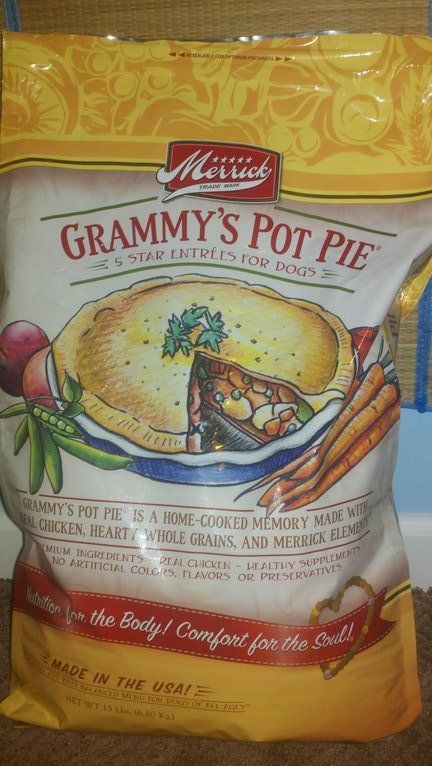 |
| The bag |
Items in italics will be discussed later.
Bag's recommended daily feeding instructions for a dog 75-100 lbs: 2¾ – 3¼ cups
Crude Protein: minimum of 24.0%
Crude Fat: minimum of 14.0%
Crude Fiber: maximum of 4.0%
Moisture: maximum of 10.0%
Calorie content: 356 kcal/cup, 3,560 kcal/kg
Calculated amount to maintain Ebon's ideal weight (82.5 lbs): 4.68 cups or 0.47 kg (1.034 lbs)
Price per pound when buying the largest bag (30 lbs at $49.99): $1.6663
Estimated cost of feeding Ebon per year on this food: $628.89 (12.58 of the 25 lb bags)
Ebon receives slightly less than the calculated feeding amount to allow for his daily treats
Ebon's overall health on this food: Not good. Though his energy level didn't change, he became itchy, vomited once, and also had rather soft stools and a very bad bout of diarrhea the day I finally took him off of the food.
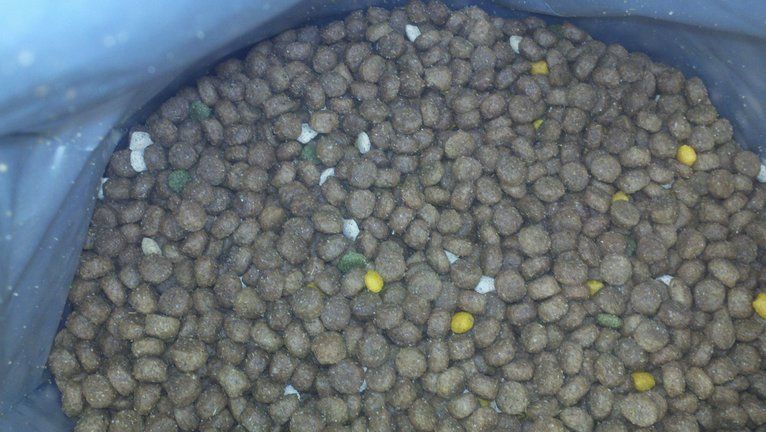 |
| The kibble. Broad picture so you can see the "Elements" |
Though I suspect an allergy, I really do not know what happened. This is why after I took him off of the food, I cleaned and sanitized every single thing that the food came in contact with in case it had something to do with a bacterium or other element on or in the food. I am not a vet, but it is suspicious that his digestion was basically back to normal as soon as I removed the food. It's true that I switched him to a bland diet immediately (rice and ground beef drained and rinsed of fat, pumpkin added for the second round), but even then such a switch usually takes a couple of days to work. Here, after he removed the food from his system he seemed to be perfectly fine.
Since Ebon was on this food for such a short period of time, I am hesitant to make any major conclusions about my opinion of the food. On its surface, it seems to be a pretty good kibble. It fits a lot of the things I like to see in kibble, such as named ingredient sources, prominent featuring of meat ingredients, inclusion of probiotics, and chelated minerals. However, the number and location of the grains on the ingredient list make it clear this food is grain-based. I did some searching around for other opinions on Merrick's foods and I have found a lot of positive reviews as well as a lot of negative ones. Overall, I give this food a hearty...meh. It clearly didn't work for Ebon, but it's quite possible other dogs could do perfectly well on it.
Will I change foods? We'll see. Next up: Blue Buffalo Wilderness.
Sunday, May 20, 2012
Guess the Genotype #72
Can you guess this dog's genotype? Its breed?
 |
| Image is from Flickr.com under a Creative Commons license |
Saturday, May 19, 2012
Crazy Plants: Rafflesia
 |
| The flower of Rafflesia arnoldii |
Here's a video of this amazing flower narrated by David Attenborough (begins at 0:30):
Sources are the Library of Congress, Southern Illinois University, Western Michigan University, and Yale Peabody Museum of Natural History. Image is from Wikimedia Commons under a Creative Commons license.
Friday, May 18, 2012
Altricial and Precocial
The terms altricial and precocial are perhaps most often applied to bird species, but can also be applied to any species of animal. The differences are based on how the young of a species act after their birth or hatch.
This term is used to refer to species that are heavily reliant on their parent(s) after birth, frequently being incapable of moving quickly independently and also sometimes being born with eyes shut tight. It is also far from unusual for the young of this type to be unable to regulate their body temperature effectively, or feed themselves. Since altricial young are born so helpless, they rely on their parent(s) for food, warmth, protection, and a number of other needs. Here are some more altricial species:
Species of this type are quite independent or "precocious" at birth. They are usually capable of walking and running very quickly, within a few hours. In some species, they still need some help in regulating their body temperature and feeding themselves. However, other species are completely on their own from birth. Here are some more precocial species:
Source is Stanford University. Images are from Wikimedia Commons and are under Creative Commons licenses or are copyright free: one, two, three, four, five, six, seven, eight.
Altricial
 |
| Altricial chicks in the nest. Note the closed eyes, lack of feathers, and inability to feed themselves |
 |
| Humans |
 |
| Dogs |
 |
| Rats |
Precocial
 |
| A precocial chick. Note the full set of feathers and open eyes |
 |
| Elephants |
 |
| Horses |
 |
| Guinea pigs |
Source is Stanford University. Images are from Wikimedia Commons and are under Creative Commons licenses or are copyright free: one, two, three, four, five, six, seven, eight.
Thursday, May 17, 2012
Wednesday, May 16, 2012
Guess the Genotype #71
Can you guess this dog's genotype? Its breed?
 |
| Image is from Flickr.com under a Creative Commons license |
Another Update on Ebon
 |
| Still as happy as ever |
There's about half or more of the bag left, but I'm getting rid of it as soon as possible. He's going back on a bland diet until his stomach settles and then I'll be moving on with the food trials. I'm also scrubbing down and sanitizing everything the food has come into contact with just in case. If his symptoms continue he'll be taking a trip to the vet. However, hopefully with plenty of fluids, the bland diet, and a touch of pumpkin he'll be better in no time.
Tuesday, May 15, 2012
Mismark Case Study: French Bulldog
This is another post I had drafted up. Since there was such a long gap between case studies, I decided to post this one as well.
The French bulldog standard is actually rather confusing in its definition of what is a "correct" color and what is not. This is what it actually says:
The exclusion of blue eyes in any standard that allows piebald dogs is...problematic. This is due to the fact that it is far from uncommon for piebald dogs to end up with blue eyes, particularly if one of their eyes is partly or completely surrounded by white. Dogs that are extreme white (aka extreme white piebald) are even more likely to have one or two blue eyes since the gene greatly increases the likelihood that the dog will have little to no white on its face. Both genes can and do occur in the breed quite frequently.
Tan point is quite unusual in the breed, but does pop up on occasion. Since it is a recessive gene, it can potentially be hidden under a wide variety of colors. Sable is dominant to tan point on the Agouti locus, and thus it is possible that sable dogs may carry the gene. Recessive red, which is seen in the breed, can hide every other color, including black and tan. It's also possible that some of the dogs identified as "black" or very heavy brindles could actually be tan point. This would be due to the layering you get between the Agouti locus (and thus tan point) and the black K locus (and thus brindle). Heavy brindle markings would make it nearly impossible to see the crisp tan markings that are present in the dog at left and would instead cause a dog to have few, if any, tan stripes visible on the legs.
Ticking, though not addressed in the official standard, is seriously frowned upon by breeders, showers, and exhibitors. Ticking is caused by a dominant gene that is only visible on a dog with white markings. As such, any solid dog that has a copy of the gene is indistinguishable from solid dogs that don't. If a solid dog that carries piebald is crosses with a piebald or another carrier and that solid dog has a copy of the ticking gene, you would get surprise ticked puppies. Since it isn't even mentioned in the standard, I don't know why it would be frowned upon in the first place since "all other colors are acceptable."
The lack of stripes thing is also a bit odd, particularly when it comes to the preferences that are seen within the breed. Among the brindles, those that are mostly black are preferred. So, basically the fewer the stripes the better. Yet a solid black dog isn't okay? To be allowable, there has to be at least one tan stripe visible on an otherwise black dog. Having a single tan mark means the dog is basically black.
Moving beyond my earlier point about dark brindle and the tan point gene, piebald throws a bit of a wrench into the works. Since the preference is for dark brindles, the more white a dog has, the more likely that what few tan stripes it may have are hidden by that white. I would suspect that there are more French bulldogs that are disqualified for being black that have white markings than those that do not. I would also say that most people that are outside of the French bulldog breed would look at a lot of the show dogs that are out there and call them black. Even if some of the dogs that are disqualified for being black are genetically black, it's still quite possible that their appearance could be a surprise. Since recessive red is seen in the breed, it's quite possible that some of the recessive red dogs out there are hiding the dominant black gene.
It is also quite possible that black in French bulldogs is actually recessive black (which is on the Agouti locus), in which case any dog could be carrying the gene. If the right two dogs come together, then a surprise black could appear. The only gene that would prevent a dog with two copies of the recessive black gene from being visibly black would be the recessive red gene.
Finally, there is the disqualification of dogs with pigment other than black. Both the liver gene and the blue gene are recessive, and thus can be carried by practically any dog. The "mouse" color that is mentioned in the standard appears to refer to both blue dogs and dogs that are expressing both blue and liver at the same time, which is in other breeds known by such names as grey, fawn, Isabella, lavender, and lilac. However, the lilac coloration is seen least often of the three due to the need of the dog being homozygous recessive for both the liver and blue genes. As such, it's quite possible that "mouse" refers only to blue and the liver+blue lilac is completely ignored by the standard. This is what is implied by the French Bulldog Club of America. This amuses me somewhat since lilac can appear quite similar to fawn in color and since the standard allows for light pigment in light colored dogs, it's possible that a lilac could be considered acceptable.
Anyway, such things simply distract from my overarching point. Except for a small possibility of blue dilution alopecia, there is nothing health-wise that would give a reason behind the exclusion of any of these colors from the standard. Thus, there really isn't any reason to exclude any of these "mismark" colors. The French bulldog is a companion breed, and as such arguments cannot be made for its working ability. However, color doesn't affect a dog's temperament, which is the biggest concern in a breed that is meant to be a companion.
Health in the breed is of even greater concern. The French bulldog has a number of issues, including serious breathing problems and a large number of their dogs being unable to give birth naturally. While these are caused by selection for short faces, large heads, and small hips, other problems are caused by a lack of genetic diversity in the breed. This list includes vertebral issues, luxating patella, and allergies. The vast majority of such issues are inherited and the reason why they become common in purebreds is due to selection and breeding methods. Heavy selection narrows genetic diversity by dropping dogs out of the gene pool entirely. By selecting for color, dogs who may be very healthy are being removed from a population due to a silly aesthetic reason. This has the potential of being very problematic for the breed.
Sources are the American Kennel Club, French Bulldog Club of America, Absolut Bullmarket French Bulldogs, and D'Accord Frenchies. Images are from Wikimedia Commons and Flickr.com under Creative Commons licenses: one, two, three, four, five, six, seven, eight, nine.
 |
| A French bulldog is one of the breed's acceptable colors: cream. |
Acceptable colors - All brindle, fawn, white, brindle and white, and any color except those which constitute disqualification. All colors are acceptable with the exception of solid black, mouse, liver, black and tan, black and white, and white with black, which are disqualifications. Black means black without a trace of brindle. - AKC French Bulldog StandardSo, what it basically says that brindle, fawn, white, and brindle and white are acceptable plus any other colors except those listed. Which basically means no other colors. My assumption is that the "other acceptable colors" includes such things as red, cream, sable, fawn piebalds, and dogs with masks. However, those could for the most part be included under the heading of "fawn." It would make much more sense to simply list the acceptable and unacceptable colors without the need to get so pointlessly wordy. Even worse is their wording on what is and is not acceptable pigment intensity to the skin and eyes. Namely, eyes must be dark and noses black except on lightly colored dogs. So, basically blue and liver aren't allowed, but according to this wording, a cream dog such as the one above could have a liver nose and be considered acceptable according to the standard. Anyway, on to the mismarks:
- Blue eyes
- Tan point
- Ticking
- White seen on dogs should be free of ticking spots
- Lack of stripes
- All black dogs must have at least one visible brindle stripe
- Non-black pigment
- Liver
- "Mouse" (apparently blue and Isabella/fawn)
 |
| This Frenchie has blue eyes |
 |
| A black and tan dog |
 |
| This puppy has ticking |
 |
| A possible black Frenchie |
 |
| A black and white Frenchie |
It is also quite possible that black in French bulldogs is actually recessive black (which is on the Agouti locus), in which case any dog could be carrying the gene. If the right two dogs come together, then a surprise black could appear. The only gene that would prevent a dog with two copies of the recessive black gene from being visibly black would be the recessive red gene.
 |
| A liver Frenchie |
 |
| A blue puppy |
 |
| A blue masked fawn |
Health in the breed is of even greater concern. The French bulldog has a number of issues, including serious breathing problems and a large number of their dogs being unable to give birth naturally. While these are caused by selection for short faces, large heads, and small hips, other problems are caused by a lack of genetic diversity in the breed. This list includes vertebral issues, luxating patella, and allergies. The vast majority of such issues are inherited and the reason why they become common in purebreds is due to selection and breeding methods. Heavy selection narrows genetic diversity by dropping dogs out of the gene pool entirely. By selecting for color, dogs who may be very healthy are being removed from a population due to a silly aesthetic reason. This has the potential of being very problematic for the breed.
Sources are the American Kennel Club, French Bulldog Club of America, Absolut Bullmarket French Bulldogs, and D'Accord Frenchies. Images are from Wikimedia Commons and Flickr.com under Creative Commons licenses: one, two, three, four, five, six, seven, eight, nine.
Monday, May 14, 2012
Mismark Case Study: Shar-pei
Thanks to the new Blogger I wrote this post a while ago, but forgot about it after it was buried under a number of other posts. I used to keep my unpublished posts always visible, so it's taking a little time to get used to.
To the Western world, our knowledge of this rather unusual looking breed is usually restricted to the type seen in the show dog above. However, a number of traits can vary greatly. Overall, the breed can be split into two major types: meat mouth and bone mouth. Meat mouth dogs are like the one above: heavily wrinkled with a puffy muzzle and lost of excess tissue overall. In contrast are the bone mouth dogs, considered to be a better representation of what the breed once was, which has far less wrinkle and less exaggerated tissue overall.
Another point of variation that many people aren't aware of are the coat variations and color variations. There are three coat types: horse, brush, and bear, with bear being disallowed by the standard. In addition, there are a wide variety of colors. The vast majority are acceptable, but a few are not. Here are the mismarks:
Though these are all mentioned in the standard, some are far more common than others. Albino, for example, may not even be present in the breed, let alone dogs in general. If it is, it's likely to be nearly indistinguishable from very pale cream dogs with skin diluted by both the liver and blue genes. If the gene is present, it's a simple recessive for which carriers cannot be easily distinguishable from non-carriers. Brindle and black and tan are quite unusual, but do still occur on occasion. Brindle is dominant to non-black/brindle (aka sable), but would be hidden by dominant black and recessive red. Black, though on the same locus, is dominant over brindle. Recessive red hides any and all black pigment that would have otherwise been expressed. Both of these genes are known to occur in the breed. Black and tan, in contrast, can be hidden by basically every other color seen in the breed. It's recessive to sable as well as hidden by dominant black and recessive red. Since all of these things are true, it makes it quite likely that the genes will never disappear from the population. Instead, they will remain hidden until the right cross causes the color to pop up.
Flowered, by far, is the most common and well known of the shar-pei mismarks. It's caused by a couple of recessive genes: piebald and extreme white. The acceptable colorations according to the standard are all genetically solid. However, considering how common the flowered coloration is, quite a number of these dogs also carry a copy of either the piebald or extreme white genes. When the right two dogs come together, they will produce puppies with white.
I have also found evidence for the occasional dog with a copy of the Irish white gene, which produces the marking pattern most often associated with such breeds as the border collie. Some shar-pei breeders do not consider this coloration part of the "flowered" term. However, since the coloration is also a mismark for the same reason as the dogs with more white, I prefer placing them in the same category. It also appears that a very large portion of the flowered shar-peis you will find are also ticked. As such, the breed as a whole likely has quite a number of individuals that are genetically ticked, but this can't be seen due to a lack of white markings.
The reason why flowered dogs pop up so frequently is likely due to the breed's history as part of the dog fancy. Like so many breeds, only a small number of dogs were used in the creation of the lines that continue to be bred today in countries like the United States. According to analysis by one breeder, due to the small gene pool basically every single shar-pei that exists today is related to a flowered dog. This makes it rather likely that they will themselves carry the gene. In fact, it's estimated that one third of the population are carriers. The color remains fairly controversial, partly since the reasons for its exclusion from the standard are rather ambiguous.
All in all, there really is no reason that flowered dogs should be considered unacceptable in the shar-pei breed. One of the biggest reasons to allow the color comes down to genetic diversity. Shar-peis suffer from a startlingly large number of inherited diseases that have come from their small founding population and selection against certain colors and characteristics and for the exaggerated, wrinkled type that is so well known today. It's really quite amazing. Since this is such an issue, and so common at that, genetic diversity if precious. It's likely that there have been many flowered dogs who are far healthier than some of the dogs that are ancestors of the dogs you see in shows today. It's unfortunate that a silly aesthetic preference has led to the irreplaceable loss of genetic diversity. In the shar-pei, out-crosses could go a long way in trying to alleviate these genetic issues, and such groups as bone mouth shar peis and mismarked meat mouth shar peis could be very helpful additions to the gene pool.
Sources are American Kennel Club, Chinese Shar-Pei Club of America, University of Saskatchewan, Royal Shar-Pei, and Jewel's Shar-Pei. Images are from Wikimedia Commons or Flickr.com and are under Creative Commons licenses or are copyright free: one, two, three, four, five, six.
 |
| A show dog in perhaps the most commonly seen color in the breed: red. The standard allows all shades of red to include cream, black, blue, liver/chocolate/brown, Isabella/lilac/fawn, and sable. |
 |
| A bone mouth shar-pei |
Another point of variation that many people aren't aware of are the coat variations and color variations. There are three coat types: horse, brush, and bear, with bear being disallowed by the standard. In addition, there are a wide variety of colors. The vast majority are acceptable, but a few are not. Here are the mismarks:
- A non-solid color other than sable
- Flowered (aka piebald, parti-color, spotted)
- Brindle
- Black and tan
- Albino
Though these are all mentioned in the standard, some are far more common than others. Albino, for example, may not even be present in the breed, let alone dogs in general. If it is, it's likely to be nearly indistinguishable from very pale cream dogs with skin diluted by both the liver and blue genes. If the gene is present, it's a simple recessive for which carriers cannot be easily distinguishable from non-carriers. Brindle and black and tan are quite unusual, but do still occur on occasion. Brindle is dominant to non-black/brindle (aka sable), but would be hidden by dominant black and recessive red. Black, though on the same locus, is dominant over brindle. Recessive red hides any and all black pigment that would have otherwise been expressed. Both of these genes are known to occur in the breed. Black and tan, in contrast, can be hidden by basically every other color seen in the breed. It's recessive to sable as well as hidden by dominant black and recessive red. Since all of these things are true, it makes it quite likely that the genes will never disappear from the population. Instead, they will remain hidden until the right cross causes the color to pop up.
 |
| Flowered liver |
 |
| Flowered red |
 |
| Flowered black |
 |
| Flowered red with a blue mask |
Sources are American Kennel Club, Chinese Shar-Pei Club of America, University of Saskatchewan, Royal Shar-Pei, and Jewel's Shar-Pei. Images are from Wikimedia Commons or Flickr.com and are under Creative Commons licenses or are copyright free: one, two, three, four, five, six.
Guess the Genotype #70
Can you guess this dog's genotype? Its breed?
 |
| Image is from Flickr.com under a Creative Commons license |
Subscribe to:
Comments (Atom)


